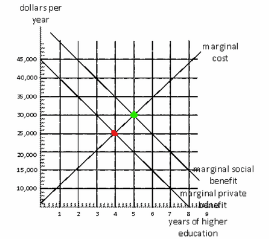4. Exhibit 17-8 represents the consumer market for higher education. Exhibit 17-8 dollars per year marginal cost 45,000 40,000 5,000 30,000 5,000 20,000 marginal social 15,000 benefit 10,000 marginal private years of higher education a. If people base their education decisions only on the marginal private benefit of education, how many years of education will they choose to get? b. What is the socially optimum number of years of education people should get? c. If the government decides to provide a subsidy to every student in order to encourage them to get the socially optimal number of years of education, how much, per year, does this subsidy have to be?

In the free market, the optimal point will be at the point where,
PMB (Private marginal benefit) = PMC (Private marginal cost)
This the market optimal point, beyond this point shown with red colour marginal cost is more than the marginal private benefit, thus people do not go for more years of higher education. While below the point mark in red colour is the point when marginal benefit is more than the marginal cost and thus it will be beneficial for people to go for further years of higher education. (Refer to the figure given below).
Thus, at point PMB = PMC, they will choose 4 years of schooling.
The socially optimum point is the point that comes when the government intervene the market to regulate it. what government does in add up the externality onto the private cost and benefit.
Externality can be positive or negative.
Externality occur when a production and consumption of goods cause an impact on the third party, not directly but indirectly through their outcomes of production and consumption.
Socially optimum condition: Social marginal cost (SMC) = Social marginal benefit (SMB)..............(1)
SMC = PMC (Private marginal cost) + MEC (Marginal external cost)..............................(2)
SMB = PMB (Private marginal benefit) + MEB (Marginal external benefit)...................(3)
Putting equation (2) and (3) in equation (1)
PMC + MEC = PMB + MEB
PMC = PMB + MEB MEC = 0

Thus the socially optimal point is that which is mark with green point, where PMC = PMB + MEB
Hence, the socially optimum years of education that people should get is 5 years.
Trending now
This is a popular solution!
Step by step
Solved in 3 steps with 1 images









